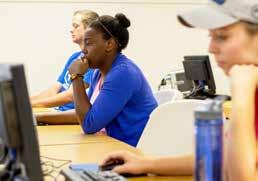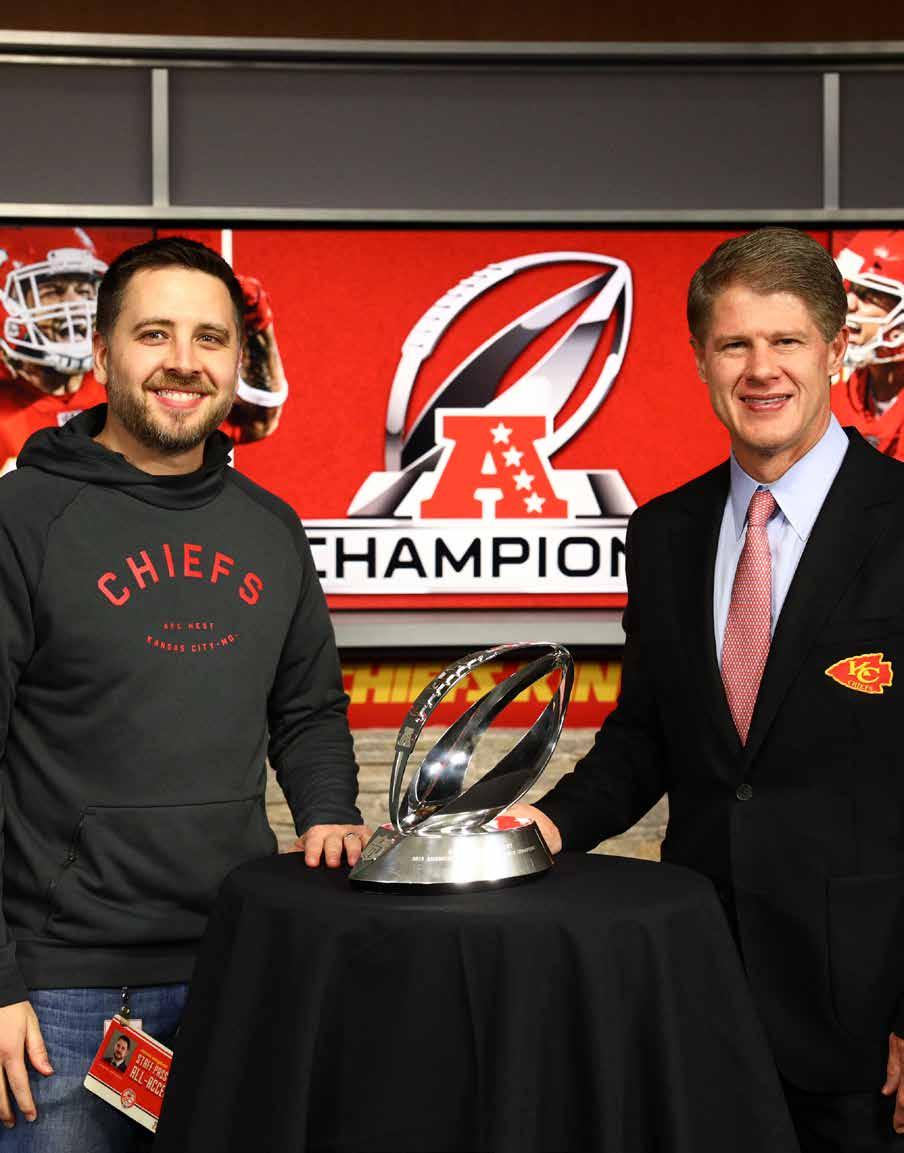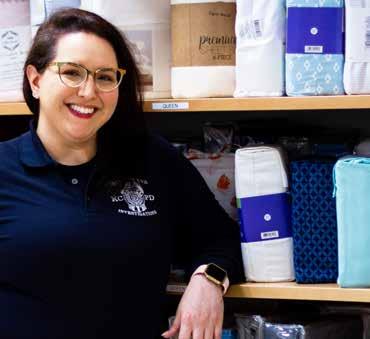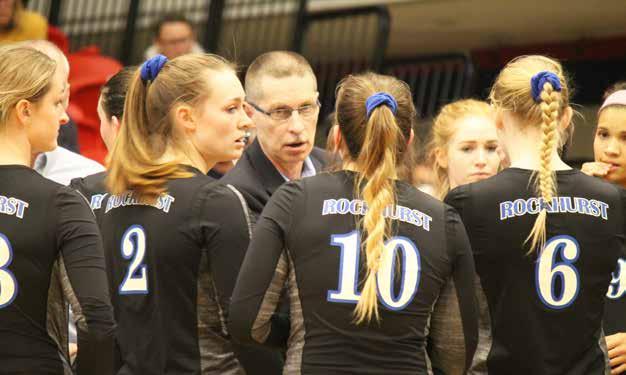
24 minute read
Athletics News
Women’s Volleyball Finishes Strong, Advances to NCAA Semifinals
Volleyball head coach Tracy Rietzke, center, speaks to his players.
The 2019 Rockhurst women’s volleyball season will be one of the most memorable seasons in school history. The Hawks (33-8) advanced to the NCAA national semifinals for the second time in three seasons and finished seventh in the final American Volleyball Coaches Association Division II Top 25 poll.
Rockhurst captured the Great Lakes Valley Conference regular season and GLVC Tournament titles for the first time since joining the GLVC in 2005. The Hawks defeated three nationally ranked teams to win their third NCAA Midwest Regional championship since 2015. Head coach Tracy Rietzke was named the 2019 U.S. Marine Corps/American Volleyball Coaches Association Division II National Coach of the Year. Rietzke ranks first all-time in Division II with 1,277 victories and stands fourth in career victories for all three levels of NCAA women’s volleyball head coaches.
“We had a great team with great assistants who did a great job preparing the team,” Rietzke said. “And the players; that’s what makes the team. Our five seniors did a great job with their leadership. I appreciate them so much. It was a great ride.”
Senior outside hitters Karli Reichert, from Kansas City, Missouri, and Alyssa Woodman, from Omaha, Nebraska, finished their college careers as two-time AVCA All-Americans. Reichert was also named a first team CoSIDA Academic All-American with a 3.98 cumulative GPA.
Over the past six years, the Hawks have compiled a 240-53 overall record. Rockhurst has appeared in six NCAA Tournaments and captured three Midwest Regional titles while winning 15 of 21 NCAA matches since 2014.

Student-Athletes Net NCAA Academic Honor For Ninth Straight Year W hen it comes to in-classroom performance, Rockhurst University’s student-athletes have earned a little on-field celebration. For the ninth year in a row, the University’s student-athletes earned the NCAA Presidents’ Award for Academic Excellence, boasting a four-year Academic Success Rate of 94%. ASR is a measure of the percentage of student-athletes who graduate within six years of their initial college enrollment. In addition to being 21 percentage points higher than the national average, the University’s ASR mark is also the best in the Great Lakes Valley Conference and among all other Division II schools in Missouri and Kansas.
Nathan Mark, a junior history and political science major and infielder on the baseball team, said for many student-athletes, success in the classroom has a lot to do with team culture.
“I have quite a few classes where I have a couple of teammates as classmates,” he said. “In these classes, we look after each other, recognizing that if one of us doesn’t succeed, it has bigger ramifications than one of us simply not passing the class.” of student-athletes at Rockhurst University graduate within six years of their initial college enrollment, the highest among GLVC schools and all Division II schools in Missouri and Kansas.
Women’s Soccer Makes NCAA Tournament Appearance
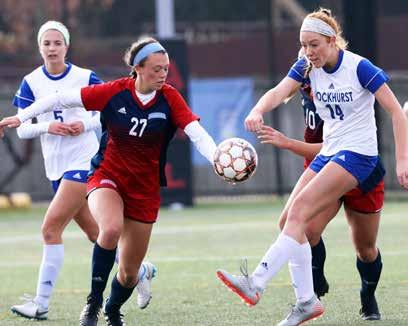
Junior Jillian Leetch (No. 14), named third team All-American and second team Scholar All-American by the United Soccer Coaches, helped lead the women’s soccer team to a 14-5-1 finish and an appearance in the NCAA Division II national tournament.
Women’s Cross Country Goes the Distance
The women’s cross country team competed at the NCAA Midwest Regional meet in November. T his season, one Rockhurst University athletics program earned its first chance to go against national competition.
The Hawks women’s cross country team qualified for the NCAA Midwest Regional Tournament, taking its top seven runners to Evansville, Indiana, to run the six-kilometer Angel Mounds track.
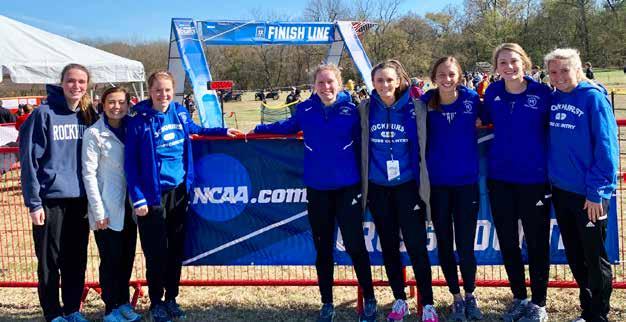
The appearance capped a season that included the Hawks capturing the team title at the Cottey College Invitational and taking fourth place at the GLVC championships. At regionals, the squad finished in 17th place. They were led by Emily Dickson, sophomore, who finished first for the Hawks in 74th place, and Sarah Harig, a student in the master of occupational therapy program, who finished second in 83rd place. Coach Kathy Strecker was proud of the team’s achievements. “Placing fourth at the GLVC meet and earning the opportunity to race at the NCAA Midwest Regional was definitely a highlight of the season,” Strecker said. “Their positive team culture impacted all aspects of cross country and it was an honor to coach this team.”
Two Hawks Hoops Teammates Achieve 1,000 Points
Two players on the Hawks men’s basketball team hit the 1,000-point mark this season: Curtis Lewis, junior from Kansas City, Missouri, and Quinton Curry, junior from West Des Moines, Iowa. They are the 19th and 20th players, respectively, in Rockhurst history to do so.
Hawks Lacrosse Player Lends Skills To Polish National Team
Freshman Jakob Setley playing for the Polish National Team in the European Junior Lacrosse Championship in Czech Republic in summer 2019. T his spring, freshman Jake Setley will begin his journey as a member of the Rockhurst University men’s lacrosse team. But his journey in the sport spans more than one squad –and more than one continent. Since summer 2019, Setley has been part of the national team for Poland, joining the squad in the European Junior Lacrosse Championships. He’s eligible thanks to his grandfather, he said, who is 100% Polish.
It was an experience many don’t get, spending six days at a training camp to prepare and then eight more in Prague, Czech Republic, competing in the European Junior Lacrosse Championships. The team played one game a day, allowing Setley and his teammates to soak in the atmosphere. For someone passionate about the sport of lacrosse, it was a once in a lifetime opportunity, one that resulted in lasting bonds among his international teammates, even after the tournament ended. “I talk to the Polish players on a weekly basis,” Setley said. This summer, he plans to do it all again, returning to Poland for training camp and then traveling to Limerick, Ireland, for the World Junior Lacrosse Championships.
“Teams from all around the world will be there, and after my experience this summer, I am beyond excited to play in it,” Setley said.
Before that global venture, Setley said he is looking forward to taking Bourke Field with a Hawks team looking to continue their recent run of success.
“My favorite part of being on the team has been building relationships with all the guys,” Setley said. “They welcomed me and the other freshmen with open arms.”
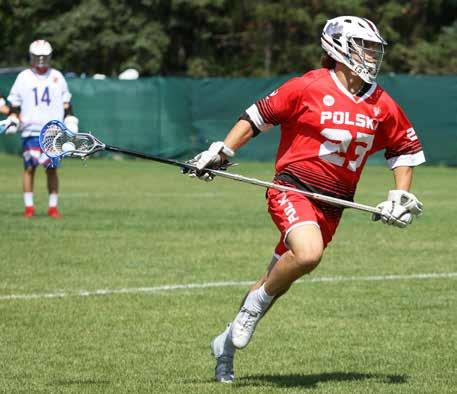
(From left) Kaitie Portell, freshman; Sarah Wilson, freshman; and Zach Ellis, junior; tutor chemistry students at a Kansas City high school.
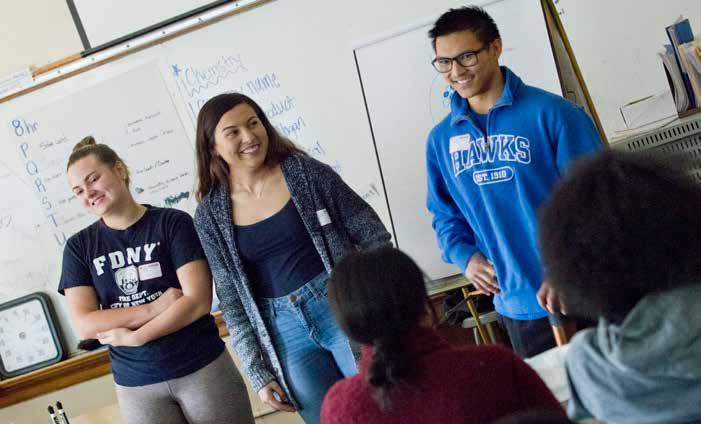
Learn, Serve, Reflect, Repeat
our Rockhurst University students — three of them freshmen — stand in front of a chemistry class at a high school near campus expecting to help with the day’s lesson. What happens next is both a testament to their ingenuity and proof that service in the community can amp up learning in ways that sitting at a desk cannot.
As the high schoolers continue to talk, joke and play with their phones, the teacher tells the RU students that Friday is career day and they don’t need to focus on chemistry. Then she sits down. It’s time to improvise. In a calm voice, Sarah Wilson, a freshman from Olathe, Kansas, asks the students for their attention and the four begin sharing stories about beefing up college applications with volunteer experience and quizzing the students about what they want to do with their lives. Among the aspirations are neurologist, neonatal nurse and dental hygienist. For 25 years, the Center for Service Learning has shown that serving the community is not just the right thing to do, it also helps students academically. F BY KATHERINE FROHOFF, ’09 EMBA
—Julia Vargas, Ed.D., director of the Center for Service Learning
With a rapport established, the talk quickly turns back to chemistry and the four tag-team an impromptu lesson, complete with flipchart notes and diagrams.
The visit is part of a general chemistry honors class taught by Annie Lee, Ph.D., professor of chemistry. And that makes it service learning.
Service learning is different from volunteer service because it is tied to academic learning as part of a class and has additional goals above and beyond contributing to communities. Like many other Jesuit universities, Rockhurst was at the onset of institutionalizing service learning, according to Julia Vargas, Ed.D., director of the Center for Service Learning, which just celebrated its 25th year in 2019.

Continued on page 14 “At a Jesuit university, it’s not education for education’s sake. We want our students to go out in the world and do good, just like the quote on our bell tower,” Vargas said. “Service learning falls right in line with Jesuit pedagogy – you have an experience, you reflect on it and you go back to see what needs to be done differently.”
Lee has been taking her students to the public high school since 2006 and she said the learning happens with both groups of students.
“Our students will learn chemistry better because they have to work on their communication skills, how to relate to the high school students and how to get their point across,” Lee said. “Explaining difficult concepts in different ways reinforces their own learning.” More importantly, the learning isn’t confined to the field of chemistry. Lee said the resources at the high school are different from those at the high schools most Rockhurst University students attended and many times their eyes are opened to the challenges these students will face when they attend college.
“I was surprised by the inequality between my high school and this one,” said Kaitie Portell, freshman. “The learning environment does not make it easy for them. I hope by continuing to go I can help make it easier for students to learn and influence their future.”
Across the state line in Prairie Village, Kansas, juniors Jordan Rehmer and Lexie Ostrander also take part in a classroom service-learning experience but with much younger children and in a way that lets them test drive their future career choice. Jordan Rehmer, junior, works with third graders Larson Robinson and Hayley Hellen at St. Ann Catholic School in Prairie Village, Kansas.
Continued from page 13
The elementary education majors present Junior Achievement lessons to third graders in Jennifer Schafer’s classroom at St. Ann Catholic School. Using their best “teacher voices,” the two lead the children in creating paper cutout buildings for a tabletop 3D city.
“We love working with them and it gives us confidence,” Ostrander said. “It reaffirms for me this is what I want to do and that I can pull it off.”
If you associate philosophy more with thinking than with acting, you may want to have a conversation with Rob Vigliotti, Ph.D., associate professor of philosophy.
“We talk a lot about the common good — if others aren’t living a good life then I’m not living a good life either,” Vigliotti said. “For some folks, it’s hard to hear that because they’ve only been focused on their own advancement and success. It’s very much part of the Catholic tradition, but some students are hearing that for the first time.”
Vigliotti said it wouldn’t make much sense to just sit in a classroom and study prominent philosophers’ thoughts on this rather than putting their ideas into action. He says he encourages students to find a place where they can serve and to use it as a laboratory to confirm or contradict philosophical theories. You might not think an animal shelter lends itself to this and neither did junior Holly Sullivan. “All I did was pet dogs and play with cats,” she said. But then she started doing research using her volunteer role at Wayside Waifs as a foundation. For Vigliotti’s ethical theory class, Sullivan explored the shelter’s no-kill policy, contrasting Immanuel Kant’s idea that animals do not have rights with Aristotle’s six virtues and how they might align with animal rights.
—Holly Sullivan, junior
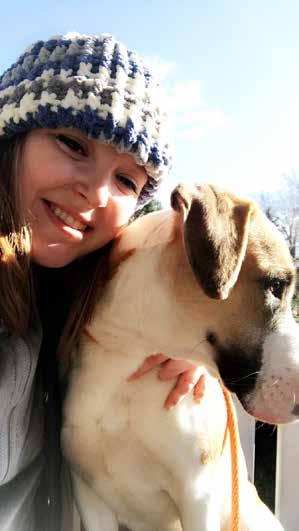
“It opened my mind a lot more. I interact with animals all the time, but I wondered if they can love. I agree with Aristotle that they do have capacities to think and to love. It made me change my viewpoint to want to help animals as much as I can.”
And, for Sullivan, that implication has parallels for the work she wants to do after completing her bachelor’s degree in the physics of medicine at Rockhurst and a master’s in prosthetics and orthotics. “My philosophy on how to treat my patients will be to focus on each one as an individual and give them the best care that I can,” she said.
During his very first semester as a freshman at Rockhurst, David Wallisch, ’12, ’13 MBA, took an English course from Dan Martin, Ph.D., associate professor of English, who incorporates service learning experiences into many of his courses. For this one, Wallisch had to perform a required number of service hours and write a research paper that related to the experience.
Wallisch, now the subsidiary controller at Midway Ford Truck Center in Kansas City, Missouri, chose to serve meals at St. James Place food pantry and food kitchen. He recalls that he wrote a paper about the local bus system.
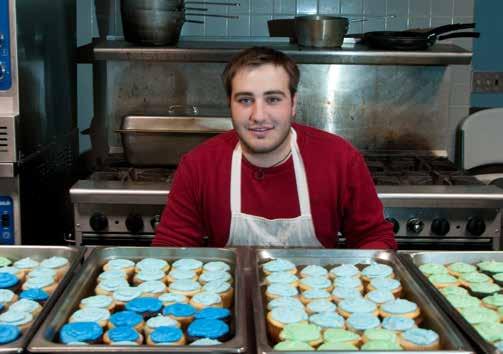
“I learned a bit about writing research papers, and about Kansas City’s bus system, but I learned a great deal more about contemplation in action,” Wallisch said.
Some of those lessons have stayed with Wallisch far beyond his college days. He recalls how he was particularly struck by one of the guests at St. James Place who made a lasting impression — Dwayne. Even though Dwayne was having trouble receiving disability checks and his motorized wheelchair wasn’t working properly, he began helping Wallisch clean up following the evening meal one night. David Wallisch, ’12, ’13 MBA, served at St. James Place food pantry when he was a student at Rockhurst.
“Times were obviously tough for Dwayne, and I made a comment to him that he didn’t need to help clean up,” Wallisch said. “Dwayne responded to me with ‘I try to do a little bit of good wherever I go.’”
Wallisch said he still takes Dwayne’s example to heart and works to emulate it by also doing a little bit of good wherever he goes. Following that first service-learning class, Wallisch continued volunteering at St. James Place throughout his undergraduate and graduate years at Rockhurst. For his 21st birthday, he turned his celebration into one for St. James Place, raising $2,100 in honor of the occasion and baking enough cupcakes for all the guests to enjoy during his volunteer shift. It is easy to find the good in that, even without writing a reflection paper.
Big Changes Come to Sedgwick Hall
BY JENNIFER KNOBEL Continued on page 18 hether you graduated five years or five decades ago, Sedgwick Hall was likely a big part of your Rockhurst experience. Throughout its lifetime, this iconic building has served as the high school, college, Jesuit residence, a residence hall and, of course, an academic building. The time has come, once again, for Sedgwick to begin a new chapter, including a major renovation. Its next challenge? To lead Rockhurst into a new era of health science education as the home of the Saint Luke’s College of Health Sciences at Rockhurst University, pending approval from regulatory bodies in early 2020.
“Sedgwick is a quintessential part of Rockhurst’s history,” said Mary Mooney Burns, ’93, vice president for university advancement. “Our alumni and donor community has stepped up tremendously to help us preserve and enhance it. With their continued support, we can reach our final goal and keep this project on schedule.”
The repurposing of Sedgwick Hall is a cornerstone of the University’s current $55 million comprehensive campaign, and an additional $6 million is needed to begin the major part of the reconstruction.
Recognizing the historical significance of the building, the project’s steering committee purposefully chose a design that preserves much of the castle-like façade. “Ninety percent to be exact,” said Jason Riordan, ’05, associate vice president of facilities, whose grandfather also used Sedgwick as a student back in the 1940s. “It is the original campus structure and we want to pay homage to that.”
Within the 55,000-square-foot renovated facility, Saint Luke’s College of Health Sciences will offer associate-level allied health programs, undergraduate and graduate nursing programs and post-graduate certificates in nursing. Demand for jobs in these fields, specifically nursing, is expected to grow significantly in the coming years. According to the U.S. Bureau of Labor Statistics, employment of registered nurses in the State of Missouri alone is projected to grow 16% by 2026. Iconic façade to remain as beloved building modernizes for 21st century health care education. W
“Sedgwick is a quintessential part of Rockhurst’s history. Our alumni and donor community has stepped up tremendously to help us preserve and enhance it.” —Mary Mooney Burns, ’93, vice president for university advancement

Top: Once completed, Sedgwick Hall will integrate technology-enabled learning studios for large groups of students. Bottom: A rendering of Sedgwick Hall shows the glass façade facing Kinerk Commons.
Continued on page 18

Continued from page 17
“The renovation is truly a collaboration between RU and Saint Luke’s,” said Hubert Benitez, D.D.S., Ph.D., president and CEO of Saint Luke’s College of Health Sciences. “It’s a union of two strong Kansas City institutions, which had the vision of joining forces to address the educational and health care needs of our region. Sedgwick Hall will house this magic, becoming a premier location for academic innovation – an environment for health sciences students to flourish.” With most of the Troost-side façade intact, the renovation will expose the quad-side of the structure with a wall of glass, mixing modern and historical elements. In addition to classrooms and study spaces, the building will feature an impressive simulation lab.
The renovated Sedgwick Hall will include flexible common areas alongside classroom space.
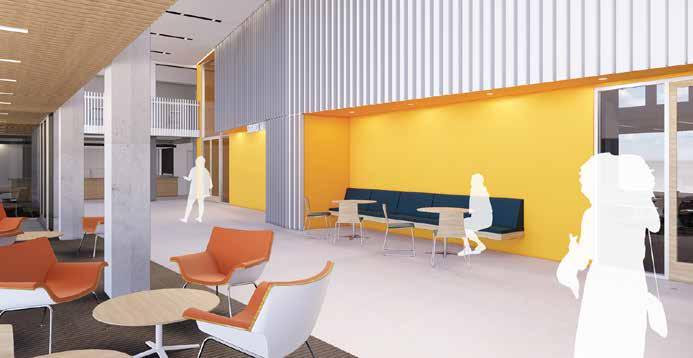
“It’s a union of two strong Kansas City institutions, which had the vision of joining forces to address the educational and health care needs of our region. Sedgwick Hall will house this magic, becoming a premier location for academic innovation – an environment for health sciences students to flourish.” —Hubert Benitez, D.D.S., Ph.D., president and CEO of Saint Luke’s College of Health Sciences
“The lab will be a wonderful addition to campus, allowing students to sharpen their skills in a controlled environment,” said Kris Vacek, OTD, dean of the College of Health and Human Services. “I think one of the most exciting elements is the additional interprofessional education opportunities the lab brings. This means a nursing student can now call on a physical or occupational therapy student for input and vice versa, creating opportunities to become more familiar with different types of health care practices. Currently, our OT and PT students have to travel to other locations to do this.”
“It’s a more robust experience for all involved,” said Benitez. “And that goes beyond academics. Saint Luke’s will bring a different demographic of students to campus – more diverse, many nontraditional, first-generation and adult learners. This is added value that can only enrich the RU experience, while making a societal change; one student and one family at a time.”
Another exciting element of the project is the addition of associate degrees, making Rockhurst one of the few Association of Jesuit Colleges and Universities institutions to do so.
“There are so many associate degrees in health care fields that Rockhurst could start to offer now with these new resources in place,” said Vacek. “I can see students earning their associate degree, and creating a pathway into a bachelor’s or even a master’s down the road.”
The steering committee has also decided to leave some unfinished space in Sedgwick for future programming needs.
“Academic program growth is inevitable,” said Riordan. “To ensure we have room to grow, the fourth floor will be what’s called ‘warm shell space,’ which means we’ll complete basic construction with no finishes, just a space that is ready for subsequent development.”
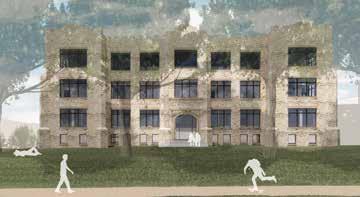
As for the timeline, interior demolition work is underway, with construction beginning October 2020 and doors opening in August 2022. Reaching the project’s total cost of $23 million will help keep the timeline on track, according to Burns.
“We’re at an exciting intersection of growth and tradition,” said Burns. “I am proud that Rockhurst continues to monitor the landscape of educational need, and that we’re constantly looking at how to meet that need. This project is just another example of RU having that foresight.”
Want to learn about Sedgwick Hall giving and naming opportunities? Contact Mary Mooney Burns at mary.burns@rockhurst.edu. The view of Sedgwick Hall from Troost Avenue.
The Art of Change BY TIM LINN
From St. Ignatius onward, Jesuits have been on the forefront of discovery and innovation. With a solid base of core values, they read the signs of the times to recreate the ways in which to reach people. At Rockhurst, this way of proceeding has even been written into the University’s strategy.
ooking to the new is nothing new for the Society of Jesus. For centuries, the Jesuits have been on the frontier of education, a perspective that lives on to this day in an approach to teaching and learning that welcomes new ideas and perspectives. In other words, of meeting people where they are. L In September, the University held a blessing for the Kateri Community, an all-new housing option for students interested in environmental sustainability or growing in their Catholic faith.

Rockhurst University’s most recent strategic plan makes that clear, emphasizing the importance of innovation and reinvention in all facets of University life — in curriculum, in administration and planning, and in student life. “Be a leader in educational innovation” is the first pillar of “Go Forth,” the 2018-2023 strategic plan, setting a tone for the University’s direction moving forward.
“There is a continuous process in higher education of reinventing. If you look back, from the land grant institutions to the community college system, there has been always evolution in higher education.” —Doug Dunham, Ph.D., provost and senior vice president of academic affairs
According to Doug Dunham, Ph.D., provost and senior vice president of academic affairs, innovation is not just an initiative, it’s a necessity. And that’s not at all out of step with history. “There is a continuous process in higher education of reinventing,” he said. “If you look back, from the land grant institutions to the community college system, there always has been evolution in higher education.”
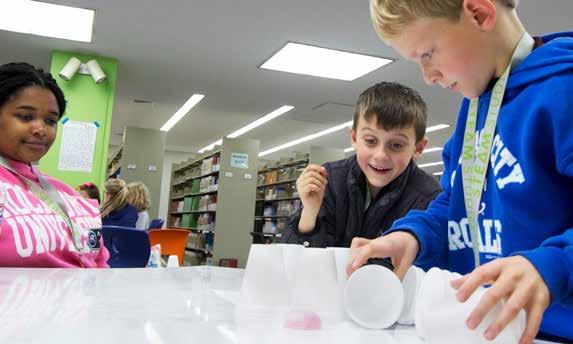
Continued on page 22 A major driver of current changes is in the numbers, Dunham said. The college-eligible population is expected to decline in the near future, and while on one hand 65% of all jobs in the United States are expected to require some form of post-secondary education by 2025, fewer than half are expected to require a four-year degree. That’s not to say a high-quality, four-year Jesuit education will disappear, but it does ask that leaders expand the notion of what a Jesuit education can be. “Employers tell us we produce thoughtful, compassionate leaders, but students’ expectations about what they are looking for when they get here continues to change,” he said. “And as the number of adult learners grows, we’re finding more people who want to ‘upskill’ — they’re looking for development, not necessarily a full degree.”
In July, Rockhurst announced an affiliation agreement with Saint Luke’s College of Health Sciences, paving the way for what, if approved, will be known as Saint Luke’s College of Health Sciences at Rockhurst University. In addition to a bachelor’s degree in nursing, it will result in new graduate degree programs, an expanded array of online programs and two-year associate degree programs geared toward nontraditional students and adult learners. As leaders at the University have repeatedly pointed out, it will likely transform Rockhurst.
That future brings both significant opportunities and challenges, a space where innovation often thrives. Mandi Sonnenberg, Ed.D., associate professor of education, knows this, having five years ago founded STEAM Studio in partnership with Gould Evans architecture firm and since opened a STEAM Studio popup in Greenlease Library. Using principles of design thinking, a unique approach to problem-solving, as well as collaboration, students in STEAM Studio face difficult challenges. And she’s seen how those circumstances often inspire new kinds of solutions.
“Everyone rises to the occasion, and it’s surprising to watch as that process of coming up with something totally new is created,” she said. Senior Dana Randolph leads an activity in the STEAM Studio Popup inside the Greenlease Library.
“Everyone rises to the occasion, and it’s surprising to watch as that process of coming up with something totally new is created,” —Mandi Sonnenberg, Ed.D., associate professor of education
Continued from page 21 An affiliation between the University and the Saint Luke’s College of Health Sciences will, if approved, provide much-needed health care professionals to the region.

That same willingness to look at challenges from new angles can be seen across the University. Nancy Donaldson, Ph.D., professor of physics, designed the physics of medicine curriculum, which teaches concepts from physics through their application in the health care fields, to attract medical students to that field. It has been a success at Rockhurst, and a National Science Foundation grant will help introduce those resources on a national scale. On the housing side, the University opened the Kateri Community, a new housing option for students passionate about growing in their Catholic faith and environmental sustainability.
Dunham said newer majors at Rockhurst are also rooted in collaboration and responding to new trends. Material science, peace and international studies, and the Bachelor of Science in analytics and technology are all the result of forward-looking interdisciplinary work and in response to what students are looking for. Through all of the change, Dunham said it is important to stay true to the Jesuit mission and core values while navigating this new terrain. The Rev. Steve Katsouros, S.J., a guest of the University’s Visiting Scholar Lecture Series in fall 2019 and dean of Arrupe College, a trailblazing two-year institution at Loyola University Chicago, said innovation naturally complements the Jesuit calling in education (see Fr. Curran’s column on Page 2). Arrupe College helps students on the margins succeed with both financial and academic support. Innovating in all directions, he said, is critical, because at the end of the day, the opportunities that a college education afford is social justice in action. “We know that colleges and universities have been the engines of social mobility,” he said. “What we’ve learned as a culture is that the more people are educated, the better it is for the country and for our individual communities.”
Since its founding, Rockhurst has placed itself on the frontier:

1909 The Rev. Michael Dowling, S.J., purchases 25 acres of land on what is the southern edge of Kansas City with the intention of founding a Jesuit school — a risky bet in an area of town without a sizable Catholic population.
1933 The evening division at then-Rockhurst College is established, the first institution in the Kansas City area to offer educational opportunities for working adults.
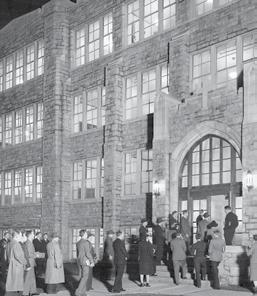
1940 The Institute of Social Order is founded, recognized nationally for a unique approach to education that included the Labour School, offering college courses to industrial workers.

1969 Recognizing changing times, Rockhurst becomes coed.
1978 Rockhurst launches the executive MBA program, a nationally pioneering business education program designed for established organizational leaders.

1983 The School of Management is established, one of the first such divisions in the area.
2005 Responding to technological needs of students, Rockhurst installs the first campuswide wireless internet network in the Kansas City region.
2019Rockhurst University announces affiliation agreement with Saint Luke’s College of Health Sciences, opening new educational opportunities to nontraditional students.
